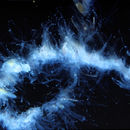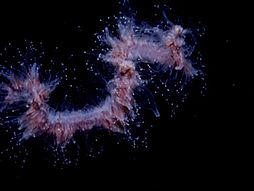mk
имиња во трошки


Apolemia uvaria, commonly known as string jellyfish, barbed wire jellyfish,[1] and long stringy stingy thingy,[2] is a siphonophore in the family Apolemiidae.[3]
As with all siphonophores, string jellyfish may appear to be a single organism, but each specimen of Apolemia uvaria is a colony of specialised minute organisms called zooids. All the zooids are attached to each other and are physiologically connected to the extent that they cannot survive alone.
String jellyfish are colonial animals that may reach 3 m in total length and have a diameter of 2–5 cm. The colony is formed of a central string, bearing groups of pink and white tentacles, which clump together or extend. The whole colony has a gas float at the front and a set of swimming bells.[4] This colonial animal is pelagic and is found in oceans worldwide in midwater.[4] These ocean predators act like drift nets, spreading their tentacles to catch plankton. The tentacles give a painful sting and are best avoided.[2][4][5]
![]() Media related to Apolemia uvaria at Wikimedia Commons
Media related to Apolemia uvaria at Wikimedia Commons

Apolemia uvaria, commonly known as string jellyfish, barbed wire jellyfish, and long stringy stingy thingy, is a siphonophore in the family Apolemiidae.
As with all siphonophores, string jellyfish may appear to be a single organism, but each specimen of Apolemia uvaria is a colony of specialised minute organisms called zooids. All the zooids are attached to each other and are physiologically connected to the extent that they cannot survive alone.
String jellyfish are colonial animals that may reach 3 m in total length and have a diameter of 2–5 cm. The colony is formed of a central string, bearing groups of pink and white tentacles, which clump together or extend. The whole colony has a gas float at the front and a set of swimming bells. This colonial animal is pelagic and is found in oceans worldwide in midwater. These ocean predators act like drift nets, spreading their tentacles to catch plankton. The tentacles give a painful sting and are best avoided.
Apolemia uvaria es una especie de cnidario hidrozoo de la familia Apolemiidae,[1]
Forma colonias flotantes que pueden llegan a alcanzar una longitud de hasta 30 m, aunque tiende a fraccionarse en partes más pequeñas, de entre 2 y 8 m.[2]
Se encuentra en el mar Mediterráneo y en los océanos Atlántico, Ártico, Índico, Pacífico y Antártico.[3]
Es una especie epipelágica.[3] Flota a la deriva, encontrándose hasta los 100 m de profundidad, aunque puede llegar a alcanzar los 800 m de profundidad.[2]
Se alimenta principalmente de peces, crustáceos, salpas y medusas.[2]
El contacto de este animal con la piel provoca un intenso escozor.[2]
Apolemia uvaria es una especie de cnidario hidrozoo de la familia Apolemiidae,
Apolemia uvaria è una specie di idrozoo sifonoforo della famiglia Apolemiidae.
Organismo epipelagico, reperibile nell'Oceano Atlantico, Mar Mediterraneo, Oceano Indiano, Antartide.
Forma catene di numerosi individui, anche migliaia, uniti a formare colonie fino a 20 metri di lunghezza.
Apolemia uvaria è una specie di idrozoo sifonoforo della famiglia Apolemiidae.
Apolemia uvaria is een hydroïdpoliep uit de familie Apolemiidae. De poliep komt uit het geslacht Apolemia. Apolemia uvaria werd in 1815 voor het eerst wetenschappelijk beschreven door Lesueur.
Bronnen, noten en/of referentiesPerlesnormanet (Apolemia uvaria) er en kolonimanet som kan bli opptil 30 m lang.
Nesletrådene har sterk gift, og kan drepe fisk. I norske farvann var denne arten ukjent for havforskerne til 1997 da den dukket opp i et oppdrettsanlegg på Fedje i Hordaland. Blant fiskere har derimot arten vært kjent lenge.
Under invasjonen i 1997 ble 10–12 tonn fisk drept i Øygarden og på Fedje. Seinere har Apolemia dukket opp hvert år på seinhøsten og vinteren, men som regel uten å gjøre skade. I 2001 var det en ny alvorlig invasjon der 600 tonn laks ble drepet av manetene, derav 400 tonn i Trøndelag.
Også andre arter kan gjøre skade i norske oppdrettsanlegg, som den lille kolonimaneten Muggiaea atlantica, og de velkjente artene glassmanet og brennmanet. Muggiaea drepte 1000 tonn oppdrettsfisk seinsommeren 2002.
Perlesnormanet (Apolemia uvaria) er en kolonimanet som kan bli opptil 30 m lang.
Nesletrådene har sterk gift, og kan drepe fisk. I norske farvann var denne arten ukjent for havforskerne til 1997 da den dukket opp i et oppdrettsanlegg på Fedje i Hordaland. Blant fiskere har derimot arten vært kjent lenge.
Under invasjonen i 1997 ble 10–12 tonn fisk drept i Øygarden og på Fedje. Seinere har Apolemia dukket opp hvert år på seinhøsten og vinteren, men som regel uten å gjøre skade. I 2001 var det en ny alvorlig invasjon der 600 tonn laks ble drepet av manetene, derav 400 tonn i Trøndelag.
Også andre arter kan gjøre skade i norske oppdrettsanlegg, som den lille kolonimaneten Muggiaea atlantica, og de velkjente artene glassmanet og brennmanet. Muggiaea drepte 1000 tonn oppdrettsfisk seinsommeren 2002.
Apolemia uvaria hay còn biết đến với tên gọi là Sứa dây thép gai là loài sứa sống ở sâu dưới đáy biển.
Sứa dây thép gai dài khoảng 3m, đường kính 2–5 cm, sinh vật này còn sở hữu một chuỗi xúc tu màu hồng, trắng co cụm lại với nhau. Khi bị quấy rầy, chúng trở nên cáu kỉnh bằng cách đổi màu sang thành xanh lá cây hoặc xanh xám. Toàn bộ xúc tu được giấu ở phần phía trước của bụng và sẽ bung ra khi nhắm được con mồi. Khi phát hiện động vật giáp xác hay cá nhỏ, những xúc tu này phát sáng và thay đổi màu liên tục nhằm thu hút đối phương. Ngay khi con mồi vào tầm ngắm, những xúc tu sẽ bật tung, đồng thời tiêm một chất vào cơ thể khiến con mồi tê liệt.

Apolemia uvaria hay còn biết đến với tên gọi là Sứa dây thép gai là loài sứa sống ở sâu dưới đáy biển.